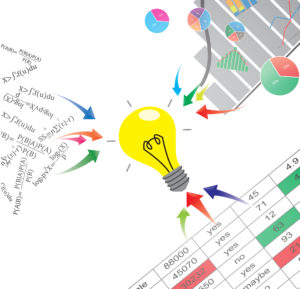Let’s say you’re going on a cross country roadtrip. We’ll pretend you’re traveling from Chicago to San Diego.
What are your first steps while planning this ambitious trip? You’d likely pull up Google Maps and get a general idea of how long it will take you to get there. You might also consider whether you want to just get there fast, or take some scenic stops along the way.
There would be lots of factors to consider: how many overnight stops you need to take, what time of day to leave (traffic could add a few hours depending!), which specific highways to take (or avoid), and if there are any landmarks you want to stop at along the way.
You’ve got 2 options of how you want to go about this trip:
Scenario 1: You’re free spirited and don’t have a time constraint. You may just get in the car, point the steering wheel west, and hope you get there. You’d still probably enjoy the ride, but you have no goals or endgame in mind.

Scenario 2: You’re heading to San Diego for a wedding or a meeting. There is obviously a set time that you need to be there, and unless you are also on vacation, you are probably on a time restriction. You will want to make your trip as efficient as possible, while also following the rules of the road and having an enjoyable experience (pit stops, food breaks, etc.).
What are the differences between these scenarios? In the first, you know your end goal but do not plan anything in between. You will still likely get there, but you might get lost and who knows how long it will take. (And you’ll probably spend a lot more on gas.)
In the second scenario, however, you will have meticulously planned your way. The directions are programmed into your GPS, you have a set departure time, you’ve got your food packed, and you know exactly when you’ll arrive.
This roadtrip example is a perfect analogy for performance improvement program design. Many of our clients know exactly what their goals are – they know where they want to end up – but are not sure how to get there. And that’s where we come in.

Program design is, by definition, the process organizations use to develop a program. It is also the plan of action that results from that process. Ideally, the process is collaborative, where all involved parties work together to create and refine a program until they believe it will effectively achieve its purpose.
First-rate program design is multi-faceted. Whether you’re building an incentive, loyalty, or employee focused program, you should take into account a variety of factors that can and will affect the overall performance of the program. This can be anything from company mission & values to industry share and potential. It is necessary to analyze a multitude of data sets, and refine the measurement models again and again until you come up with the optimal model.
Here, we will discuss the 4 aspects of program design:
- Research
- Analysis
- Design
- Measurement
“It’s surprising how few incentive and reward programs actually get measured. Those companies that believe in the programs often don’t feel a need to measure them, and those that don’t believe in the efficacy of rewards and recognition aren’t swayed even by the best of evidence.” –Bruce Bolger, “How Engagement Will Affect the Rewards Business,” Rewards Recognition Network Magazine
Research
We believe that if there is data or a measurement, then we can design a program. Taking risk out of an initiative and adding predictability increases the success for the client as well as our partnership with them. Understanding the past performance, current influences and where the market and competitors are going will help guide your program’s design for the best opportunity to be successful.
Analysis
During the analysis phase we dive into all the research we’ve collected and merge that with what we believe the participants would be capable of delivering. It’s just like taking that trip from Chicago to California: you can map your trip and get there as you wanted, or you can just start driving and hope you find it.
This area of program design can be critical. If you aren’t prepared for your cross country road trip appropriately, you may never end up in your desired destination. It’s imperative that you fully understand where you are, where you want to go, and exactly how you want to get there.
Design
Effective design gives you the most predictable results. We look at different models and scenarios  and test different rule structures. This is important to our clients because it can limit risk of over rewarding while under performing, optimize the motivating factor for the participants, and it allows accurate budgeting and expectations of the program’s performance. We also set benchmarks to be able to evaluate the performance throughout the program, giving our clients flexibility to react to new priorities.
and test different rule structures. This is important to our clients because it can limit risk of over rewarding while under performing, optimize the motivating factor for the participants, and it allows accurate budgeting and expectations of the program’s performance. We also set benchmarks to be able to evaluate the performance throughout the program, giving our clients flexibility to react to new priorities.
Our recommendations include how to best track program participant performance, communicate the program to make the most of the interactions with our client’s customers or employees, and provide you with actionable information (ie, business intelligence).
Since we look at each client as a new solution, we let the investigative process dictate the timeframe. Together with the client, we refine data models, look at different groups of potential participants and what the industry is projecting to agree on a final program.
If you, the client, provide data, we typically take 2 – 4 weeks to agree on a design. Otherwise, we can look at program rule structures and supporting tracking and communications in a couple of weeks.
Measurement
 Success is measured by how well we accomplish the objectives set out in the design phase. If there is no thought or time put into it in the beginning, it is difficult to say what was accomplished. This is why the early stages of design are vital – we want to be able to measure exactly where you wanted to go, and how we got you there.
Success is measured by how well we accomplish the objectives set out in the design phase. If there is no thought or time put into it in the beginning, it is difficult to say what was accomplished. This is why the early stages of design are vital – we want to be able to measure exactly where you wanted to go, and how we got you there.
At MEI there is a post-program analysis in place for every client, but there should be no surprises when the program is done. Throughout the entire program (which can be months or even years), we conduct periodic performance reviews and provide monthly tracking and forecast reports to our clients. We look at the areas going well in addition to areas that may need to be addressed as we go through the program.
From there, we can develop the next program design, starting with the client’s current performance and grow their business the following year. Continual and predictable performance allows our clients to run their business while MEI provides exceptional design and business intelligence, helping grow market share as well as brand loyalty.
Know your end goal, carefully plan your route and you will end up exactly where you want to go.
Performance by Design is important to us; it’s our namesake. If you are looking for program enhancements or need to start from scratch, we can help. Check out our website for more info or contact us to discuss your needs.
By Bob Graham, VP of Client & Technology Services at Motivation Excellence
Bob has over 25 years of experience in designing and delivering performance improvement services. With his experience in turnkey, integrated solutions, Bob sets strategic direction to the entire solution development process, delighting clients with innovative solutions. He directs internal & external marketing, client solution development, creative services including program management, graphic design, purchasing, and catalog management and customer service.




